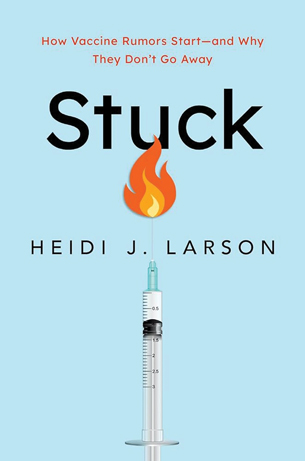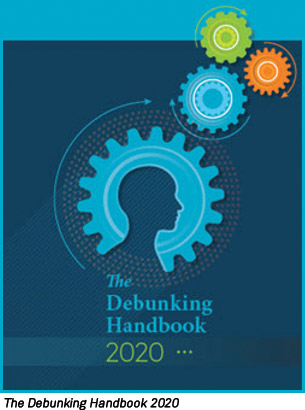
Everywhere around the world, death and destruction are fueled by misinformation (that which is incorrect) and disinformation (the deliberate spread of misinformation). It stops many people from getting appropriate medical care. Worse, it spreads faster on social media than does factual information, according to at least one study.
CROI 2023, the largest HIV medical conference in the United States, took on bad actors in the information world in a special presentation.
One surprising fact: the term “fake news” isn’t new. It’s more than a hundred years old.
It took the truth about six times as long as falsehood to reach 1,500 people.
GO TO croiconference.org for a webcast of Science Communication in the Age of Misinformation for these presentations along with a talk by Scott Ratzan of the City University of New York (CUNY). The school has established an online master’s program that takes on misinformation, Health Communication for Social Change.
Taking on health lies
Looking specifically at vaccine misinformation, “the first thing to notice is that there’s just a lot of it,” said Emily Vraga, an associate professor at the University of Minneapolis’ Hubbard School of Journalism and Mass Communication. A meta-analysis examining several studies published in 2021 in the Journal of Medical Internet Research (who knew?) reported that 37% of vaccine information on YouTube was misinformation, as was 26% on Twitter and 33% on social media overall.
“Part of this problem, though, is that there are places where it’s increasingly hard to know how much misinformation there is,” Vraga said. “It’s not a mistake that we know a lot more about misinformation on Twitter [now known as “X”] and YouTube. Those are the most public social media platforms. As more and more of this conversation moves into spaces that researchers cannot access, more and more of this problem becomes something we just don’t know about… something we cannot even begin to address because we don’t know it exists.”
She said misinformation matters because people believe it. Another study reported that nearly 8 out of 10 individuals surveyed either believed or were unsure about common falsehoods about COVID-19 or its vaccines, such as the incorrect notion that pregnant women shouldn’t get vaccinated.
She also cited a study that found that 65% of all vaccine misinformation came from 12 online accounts.
“On social media, it’s not always easy to know the difference between misinformation and disinformation because we don’t know someone’s intent. But what we do know is a lot of vaccine misinformation is coming from a very few bad actors,” Vraga said. “Now they’re not the only one sharing it. They spread it and then my aunt picks it up and believes it and shares it with me.”
She pointed to a 2018 report in Science by Dartmouth assistant professor of computer science Soroush Vosoughi and colleagues which declared that, “Falsehood diffused significantly farther, faster, deeper and more broadly than the truth in all categories of information, and the effects were more pronounced for false political news than for false news about terrorism, natural disasters, science, urban legends or financial information.”
The researchers also reported that “it took the truth about six times as long as falsehood to reach 1,500 people.”
Moreover, information is politicized. The non-partisan Pew Research Center found a general decline in trust of medical scientists and scientists among both Republicans and Democrats, but more so among Republicans. This matched a greater death rate from COVID-19 in red states than blue states.
“It’s hardly surprising that a lot of Republicans are increasingly distrustful of our medical organizations, the people who are encouraging vaccination. If you don’t trust them, you’re not going to get vaccinated,” Vraga noted. Moreover, “On social media, we’ve learned time and time again that misinformation is much more engaging than accurate information.”
The same is true of mpox, Vraga said.
Part of the reason people believe falsehoods, she said, is due to information overload. There is so much information available online that people may struggle to find what they need to know. Vraga herself looked a long time to figure out when her child’s vaccine booster could be given. Others might give up and be willing to accept whatever information pops up first—or easiest.
Then there’s the question of gatekeepers, the people through whom information flows.
“There are fewer gatekeepers that we can depend upon to make sure they’re vetting [checking] information. So, for example, one study found that a lot [33%] of Generation Z trust TikTok more than their doctors for medical information, something that should be really concerning if you’ve spent any time on TikTok,” Vraga said.
…one study found that a lot [33%] of Generation Z trust TikTok more than their doctors for medical information, something that should be really concerning if you’ve spent any time on TikTok.
Knowing that information can help, however. The White House, for example, reported last year that it will turn to TikTok more in order to reach younger audiences.
“But at the same time,” Vraga pointed out, “this is a space where we can’t just allow whoever’s on TikTok—and there are a lot of people there—to determine what is true and what is false, to determine what people are believing about information.”
Given the facts, people can protect themselves.
The title of a study from the Czech Republic addresses this point well: “Communicating doctors’ consensus persistently increases COVID-19 vaccinations.”
Vraga said that while 9 out of 10 Czech doctors surveyed supported vaccination, many individuals in the country thought the number was much lower, about 50 or 60%. When they learned that the consensus was actually 90%, they became more likely to seek out vaccination.
“That was a huge gap,” said Vraga. “The good news is that correcting that gap—giving people accurate information—increased their intentions to get vaccinated, and these are long-term effects. So if they didn’t just increase intentions as vaccine rollout continued, people who saw that correction, who learned that 90% of doctors in their country supported vaccination, were more likely to actually go out and get the vaccine when they’re eligible.
“This is known as a gateway belief model. When we know the scientific consensus on a topic, that’s incredibly convincing. It doesn’t just switch our attitudes. It changes our actual behaviors,” Vraga said.
Global visions
Around the world, different groups of people react in similar ways to health care. Many groups share medical mistrust and reject government mandates or recommendations.
In her book Stuck: How Vaccine Rumors Start and Why They Won’t Go Away, Heidi J. Larson of the London School of Hygiene and Tropical Medicine, in Brussels, Belgium, includes a chapter on “Emotional Contagion.” As she told the CROI audience, misinformation is one thing, but “where’s the appetite for misinformation and disinformation coming from?”
“Infodemics [in general, false or misleading information around disease] are not only about misinformation,” she said. “They reflect deeper emotions, beliefs and the polarization of publics [groups] that amplify the speed.”
Larson pointed to a medical reference book that used to sit on shelves and was used “for God knows how long.” Today, information spreads quickly and widely—but this includes misinformation.
“So there’s volatility [rapid change]. That is partly because of the information environment. Wildfires [of information], the viral spread, emotional contagion—how viral emotions are becoming and that’s partly mediated by YouTube videos and the increasingly emotive nature of spread and the power of belief,” said Larson, an anthropologist who’s originally from the U.S.
Some people latch on to the title of the last chapter in her 2018 book: Pandemics and Publics.
“I wrote the last chapter, and the book came out just before COVID. Some people say, ‘you knew it—you should have told us.’ I think we all knew it. We just didn’t know when [a pandemic would strike],” said Larson.
Larson and colleagues travel the world surveying people about their responses to health care information. They have since 2015 measured confidence in vaccines. Among the issues raised by many individuals was the fear of dying after a COVID vaccination or of being microchipped without their permission via the vaccination, as one rumor has it.
“I have a cartoon from the 1800s that uses the term ‘fake news.’ It wasn’t [then-president] Trump inventing it for the very first time. What is different now is the rapid speed and scale,” said Larson. “What is giving that traction? There is the issue of the algorithms that are the business plan of the social media companies. But the bigger viral spread of misinformation is about emotions. It’s about beliefs. It’s about the polarization of publics, who are hungry for another story, because they’re not happy with the story they’re getting.”
In a protest in California against vaccinations, a banner was waved that declared, “This is the new civil rights movement,” which some people found offensive. Larson noted a quote from the head of the U.S. Food and Drug Administration (FDA) from last year (2022).
“I actually believe that misinformation is the leading cause of death right now in the U.S. because whether we’re looking at COVID or chronic disease, people are making bad choices driven by the information that they get,” said FDA commissioner Robert Califf.
Larson added that, “It’s about ideology, notions of freedom. But it’s way beyond that. These kinds of emotive, organized movements couldn’t care less about the facts. You can spend all your time debunking and it just angers them, because that’s not their point. They’ve got something else going on.”
Misinformation still needs to be countered, she said. “But there is another sector—and unfortunately, it’s growing at a fast speed—of these ideological, belief-driven publics.”
She showed a newspaper report of COVID vaccination protesters in Brussels, a city not given to protests around health issues, she said. Their signs included the word, “Liberty.” In South Africa, there were 511 protests around the COVID-19 lockdown in one five-month period.
These were just two examples of protest movements around the globe. More concerning, said Larson, was the pushback on childhood vaccinations.
“When you see the significant drops in confidence in childhood vaccine, in routine immunization, that’s a worry,” she said.
Sometimes it seems possible that rumors might be true. There was, for example, an incorrect report of two cases of the Marburg virus from Equatorial Guinea found in neighboring Cameroon.
“It is perfectly plausible that it could have come across the border. These were a couple of border towns,” said Larson. “So, we do have to understand there are certain situations that have a plausibility, when they’re not getting a different story.
“And one of the oldest persisting rumors is about sterilization—anxiety about sterilization and vaccines,” Larson noted.
It constantly amazes me how little scrutiny there is on anything that’s natural
One anthropologist colleague who looked at sterilization rumors across Africa found they extended beyond vaccines and into concerns about micronutrients and quinine.
“Again, it’s about people feeling like they can’t trust the government,” Larson said. “Now, we’ve got another problem when the U.S. government and the CIA fake a vaccine campaign in Pakistan. That doesn’t help me in my job. I was out there with UNICEF telling people, Don’t worry. The CIA is not trying to spy on you with this polio campaign. I’m glad I hadn’t seen this before in my 10 years of work in that program, because it would have been much harder to do my job. As one of my colleagues said, Why couldn’t they pick the milkman instead of faking a vaccine campaign to find Osama bin Laden?”
Despite all the analyses of the vaccines, she said, “It’s about civil liberties. It’s about morality, etiology, religious beliefs, natural [substances], Mother Nature. It constantly amazes me how little scrutiny there is on anything that’s natural. If you put nature on it, people are not going to ask about it. But the level of questioning we get around scientific, evidence-based things—they get much more scrutiny.”
The struggles that broke out over the use of science to control death and disease in the face of the COVID-19 pandemic ended up taking many people by surprise.
“A lot of people in the world had no clue there were these alternative, negative, anti-vaccine sentiments going around a vaccine. They were totally shocked to find it when they started to look for information. Who would have expected a group of truck drivers to organize and block a border because of having an opinion about vaccines? And this was lining up with the right-wing extremists,” Larson said.
She quoted another national leader.
“The president of Tanzania, who died of COVID, said, ‘Pray to God.’ In Tanzania, we had people selling COVID organics [to control the virus] to different countries, saying that would cure them. We also saw polio workers and Ebola workers killed. They were killed by people because of fear and anxiety and [questions of] where are you coming from and what do you really want here? So this was not about misinformation. This was about anger, fear, not having enough information, not having had the kind of preparedness to understand, What are these people coming for? What’s going on?”
That’s where partnerships need to be made, said Larson: “Histories matter. Community histories matter. Distrust may be justified. That’s a challenge to me. You can’t go in there and say, let’s build trust when you know that communities in some countries ... I wouldn’t trust some of the governments. So we need to find things that they can build trust in. We need to embed facts when we are there with empathy. We need to make it relatable to their lives.” And, trusted local individuals need to be engaged.
One more thing: Larson said that science and research need to build in funding for communication work. It doesn’t happen by itself.
Resources
GO TO skepticalscience.com for The Debunking Handbook 2020 by Vraga and colleagues, available in 18 translations with more to come.
For more about the IRIS Academic Research Group, founded by Larson and other researchers to take on infodemics,
GO TO irisacademic.org.
For the Centers for Disease Control and Prevention (CDC) manual on health communication,
GO TO cdc.gov/eis/field-epi-manual/chapters/Communicating-Investigation.html.




